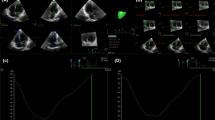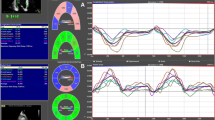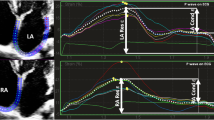Abstract
Morphology and functions of the right ventricle (RV) show differences in the athletes based on whether exercising acutely or chronically. Temporary RV dysfunction occurs during acute exercise. However, RV functions during chronic exercise are speculative. In the present study, we aimed to evaluate RV functions of long-distance runners, who perform chronic exercise, by both conventional and speckle-tracking echocardiography. In this study, we examined 44 long-distance runner and 30 sedentary subjects. RV longitudinal strain (LS), RV systolic longitudinal strain rate (LSRs), RV early diastolic longitudinal strain rate and late diastolic longitudinal strain rate parameters were evaluated by apical 4-chamber gray-scale imaging through the septum and free wall of RV in accordance with automated function imaging protocol. It was observed on the conventional echocardiographic parameters of longdistance runners that RA and RVED diameter have been increased (p = 0.028; p = 0.003 respectively), whereas systolic right ventricle fractional area change and tricuspid annular plane systolic excursion values were similar to those of sedentary subjects (p = 0.65; p = 0.75 respectively). LS and systolic and diastolic strain rate functions were also similar. Morphological adaptation, but not functional change, occurs in the athletes performing chronic exercise.

Similar content being viewed by others
References
Pellicia A, Maron BJ (1997) Outer limits of the athlete’s heart: the effect of gender and relevance to the differential diagnosis with primary cardiac diseases. Cardiol Clin 15:381–396
Oxborough D, Shave R, Warburton D, Williams K, Oxborough A, Charlesworth S et al (2011) Dilatation and dysfunction of the right ventricle immediately after ultraendurance exercise: exploratory insights from conventional two-dimensional and speckle tracking echocardiography. Circ Cardiovasc Imaging 4:253–263
McKechnie J, Leary W, Noakes T, Kallmeyer J, MacSearraigh E, Oliver L (1979) Acute pulmonary oedema in two athletes during a 90-km running race. S Afr Med J 56:261–265
Oxborough D, Shave R, Middleton N, Whyte G, Forster J, George K (2006) the impact of marathon running upon ventricular function as assessed by 2D, Doppler, and tissue-Doppler echocardiography. Echocardiography 23:635–641
Heidbuchel H, Hoogsteen J, Fagard R, Vanhees L, Ector H, Willems R et al (2003) High prevalence of right ventricular involvement in endurance athletes with ventricular arrhythmias. Role of an electrophysiologic study in risk stratification. Eur Heart J 24:1473–1480
La Gerche A, Robberecht C, Kuiperi C, Nuyens D, Willems R, de Ravel T et al (2010) Lower than expected desmosomal gene mutation prevalence in endurance athletes with complex ventricular arrythmias of right ventricular origin. Heart 96:1268–1274
Dávila-Román VG, Guest TM, Tuteur PG, Rowe WJ, Ladenson JH, Jaffe AS (1997) Transient right but not left ventricular dysfunction after strenuous exercise at high altitude. J Am Coll Cardiol 30:468–473
Teske AJ, Prakken NH, De Boeck BW, Velthuis BK, Martens EP, Doevendans PA et al (2009) Echocardiographic tissue deformation imaging of right ventricular systolic function in endurance athletes. Eur Heart J 30:969–977
D’Andrea A, Caso P, Bossone E, Scarafile R, Riegler L, Di Salvo G et al (2010) Right ventricular myocardial involvement in either physiological or pathological left ventricular hypertrophy: an ultrasound speckle-tracking two-dimensional strain analysis. Eur J Echocardiogr 11:492–500
Scharhag J, Schneider G, Urhausen A, Rochette V, Kramann B, Kindermann W (2002) Athlete’s heart: right and left ventricular mass and function in male endurance athletes and untrained individuals determined by magnetic resonance imaging. J Am Coll Cardiol 40:1856–1863
Markiewicz W, Sechtem U, Higgins CB (1987) Evaluation of the right ventricle by magnetic resonance imaging. Am Heart J 113:8–15
Amundsen BH, Helle-Valle T, Edvardsen T, Torp H, Crosby J, Lyseggen E (2006) Noninvasive myocardial strain measurement by speckle tracking echocardiography: validation against sonomicrometry and tagged magnetic resonance imaging. J Am Coll Cardiol 47:789–793
Dandel M, Hetzer R (2009) Echocardiographic strain and strain rate imaging-clinical applications. Int J Cardiol 132:11–24
Lang RM, Bierig M, Devereux RB, Flachskampf FA, Foster E, Pellikka PA et al (2005) Recommendations for chamber quantification: a report from the American Society of Echocardiography’s Guidelines and Standards Committee and the Chamber Quantification Writing Group, developed in conjunction with the European Association of Echocardiography, a branch of the European Society of Cardiology. J Am Soc Echocardiogr 18:1440–1463
Rudski LG, Lai WW, Afilalo J, Hua L, Handschumacher MD, Chandrasekaran K et al (2010) Guidelines for the echocardiographic assessment of the right heart in adults: a report from the American Society of Echocardiography endorsed by the European Association of Echocardiography, a registered branch of the European Society of Cardiology, and the Canadian Society of Echocardiography. J Am Soc Echocardiogr 23:685–713
Lang RM, Bierig M, Devereux RB, Flachkampf FA, Foster E, Pellikka PA et al (2006) Recommendations for chamber quantification. Eur J Echocardiogr 7:79–108
Mor-Avi V, Lang RM, Badano LP, Belohlavek M, Cardim NM, Derumeaux G et al (2011) Current and evolving echocardiographic techniques for the quantitative evaluation of cardiac mechanics: ASE/EAE consensus statement on methodology and indications endorsed by the Japanese Society of Echocardiography. J Am Soc Echocardiogr 24:277–313
Calleja AM, Jiamsripong P, Alharthi MS, Cha S, Cho EJ, McMahon EM et al (2009) Correlation of automated function imaging (AFI) to conventional strain analyses of regional and global right ventricular function. J Am Soc Echocardiogr 22:1031–1039
Pluim BM, Zwinderman AH, van der Laarse A, van der Wall EE (2000) The athlete’s heart. A meta-analysis of cardiac structure and function. Circulation 101:336–344
Henriksen E, Landelius J, Wesslen L, Arnell H, Nystrom-Rosander C, Kangro T et al (1996) Echocardiographic right and left ventricular measurements in male elite endurance athletes. Eur Heart J 17:1121–1128
La Gerche A, Connelly KA, Mooney DJ, MacIsaac AI, Prior DL (2008) Biochemical and functional abnormalities of left and right ventricular function after ultra-endurance exercise. Heart 94:860–866
D’Andrea A, Caso P, Sarubbi B, Limongelli G, Liccardo B, Cice G (2003) Right ventricular myocardial adaptation to different training protocols in top-level athletes. Echocardiography 20:329–336
La Gerche A, Burns AT, Mooney DJ, Inder WJ, Taylor AJ, Bogaert J (2012) Exercise-induced right ventricular dysfunction and structural remodelling in endurance athletes. Eur Heart J 33:998–1006
Kasikcioglu E, Oflaz H, Akhan H, Kayserilioglu A (2005) Right ventricular myocardial performance index and exercise capacity in athletes. Heart Vessel 20:147–152
Anavekar NS, Gerson D, Skali H, Kwong RY, Yucel EK, Solomon SD (2007) Two-dimensional assessment of right ventricular function: an echocardiographic-MRI correlative study. Echocardiography 24:452–456
Teske AJ, De Boeck BW, Olimulder M, Prakken NH, Doevendans PA, Cramer MJ (2008) Echocardiographic assessment of regional right ventricular function: a head-to-head comparison between 2-dimensional and tissue Doppler-derived strain analysis. J Am Soc Echocardiogr 21:275–283
Teske AJ, De Boeck BWL, Melman PG, Sieswerda GT, Doevendans PA, Cramer MJ (2007) Echocardiographic quantification of myocardial function using tissue deformation imaging, a guide to image acquisition and analysis using tissue Doppler and speckle tracking. Cardiovasc Ultrasound 5:27
Conflict of interest
The authors have declared that they have no conflicts of interest.
Author information
Authors and Affiliations
Corresponding author
Rights and permissions
About this article
Cite this article
Simsek, Z., Tas, M.H., Gunay, E. et al. Speckle-tracking echocardiographic imaging of the right ventricular systolic and diastolic parameters in chronic exercise. Int J Cardiovasc Imaging 29, 1265–1271 (2013). https://doi.org/10.1007/s10554-013-0204-z
Received:
Accepted:
Published:
Issue Date:
DOI: https://doi.org/10.1007/s10554-013-0204-z




